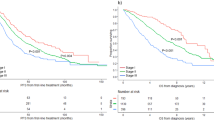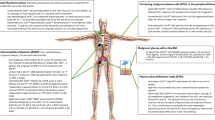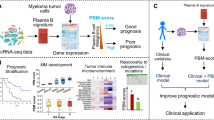Abstract
The combination of serum β2-microglobulin and albumin levels has been shown to be highly prognostic in myeloma as the International Staging System (ISS). The aim of this study was to assess the independent contributions of ISS stage and cytogenetic abnormalities in predicting outcomes. A retrospective analysis of international studies looking at both ISS and cytogenetic abnormalities was performed in order to assess the potential role of combining ISS stage and cytogenetics to predict survival. This international effort used the International Myeloma Working Group database of 12 137 patients treated worldwide for myeloma at diagnosis, of whom 2309 had cytogenetic studies and 5387 had analyses by fluorescent in situ hybridization (iFISH). Comprehensive analyses used 2642 patients with sufficient iFISH data available. Using the comprehensive iFISH data, combining both t(4;14) and deletion (17p), along with ISS stage, significantly improved the prognostic assessment in terms of progression-free survival and overall survival. The additional impact of patient age and use of high-dose therapy was also demonstrated. In conclusion, the combination of iFISH data with ISS staging significantly improves risk assessment in myeloma.
This is a preview of subscription content, access via your institution
Access options
Subscribe to this journal
Receive 12 print issues and online access
$259.00 per year
only $21.58 per issue
Buy this article
- Purchase on Springer Link
- Instant access to full article PDF
Prices may be subject to local taxes which are calculated during checkout




Similar content being viewed by others
References
Durie BG, Salmon SE, Moon TE . Pretreatment tumor mass, cell kinetics, and prognosis in multiple myeloma. Blood 1980; 55: 364–372.
Bataille R, Durie BG, Grenier J, Sany J . Prognostic factors and staging in multiple myeloma: a reappraisal. J Clin Oncol 1986; 4: 80–87.
Bataille R, Durie BG, Grenier J . Serum beta2 microglobulin and survival duration in multiple myeloma: a simple reliable marker for staging. Br J Haematol 1983; 55: 439–447.
Bataille R, Boccadoro M, Klein B, Durie B, Pileri A . C-reactive protein and beta-2 microglobulin produce a simple and powerful myeloma staging system. Blood 1992; 80: 733–737.
Bataille R, Jourdan M, Zhang XG, Klein B . Serum levels of interleukin 6, a potent myeloma cell growth factor, as a reflect of disease severity in plasma cell dyscrasias. J Clin Invest 1989; 84: 2008–2011.
Greipp PR, Leong T, Bennett JM, Gaillard JP, Klein B, Stewart JA et al. Plasmablastic morphology—an independent prognostic factor with clinical and laboratory correlates: Eastern Cooperative Oncology Group (ECOG) myeloma trial E9486 report by the ECOG Myeloma Laboratory Group. Blood 1998; 91: 2501–2507.
Greipp PR, San Miguel J, Durie BG, Crowley JJ, Barlogie B, Bladé J et al. International staging system for multiple myeloma. J Clin Oncol 2005; 23: 3412–3420.
Zojer N, Königsberg R, Ackermann J, Fritz E, Dallinger S, Krömer E et al. Deletion of 13q14 remains an independent adverse prognostic variable in multiple myeloma despite its frequent detection by interphase fluorescence in situ hybridization. Blood 2000; 95: 1925–1930.
Facon T, Avet-Loiseau H, Guillerm G, Moreau P, Geneviève F, Zandecki M et al. Chromosome 13 abnormalities identified by FISH analysis and serum beta2-microglobulin produce a powerful myeloma staging system for patients receiving high-dose therapy. Blood 2001; 97: 1566–1571.
Moreau P, Facon T, Leleu X, Morineau N, Huyghe P, Harousseau JL et al. Recurrent 14q32 translocations determine the prognosis of multiple myeloma, especially in patients receiving intensive chemotherapy. Blood 2002; 100: 1579–1583.
Fonseca R, Blood E, Rue M, Harrington D, Oken MM, Kyle RA et al. Clinical and biologic implications of recurrent genomic aberrations in myeloma. Blood 2003; 101: 4569–4575.
Jaksic W, Trudel S, Chang H, Trieu Y, Qi X, Mikhael J et al. Clinical outcomes in t(4;14) multiple myeloma: a chemotherapy-sensitive disease characterized by rapid relapse and alkylating agent resistance. J Clin Oncol 2005; 23: 7069–7073.
Gertz MA, Lacy MQ, Dispenzieri A, Greipp PR, Litzow MR, Henderson KJ et al. Clinical implications of t(11;14)(q13;q32), t(4;14)(p16.3;q32), and −17p13 in myeloma patients treated with high-dose therapy. Blood 2005; 106: 2837–2840.
Chng WJ, Kuehl WM, Bergsagel PL, Fonseca R . Translocation t(4;14) retains prognostic significance even in the setting of high-risk molecular signature. Leukemia 2008; 22: 459–461.
Hanamura I, Stewart JP, Huang Y, Zhan F, Santra M, Sawyer JR et al. Frequent gain of chromosome band 1q21 in plasma-cell dyscrasias detected by fluorescence in situ hybridization: incidence increases from MGUS to relapsed myeloma and is related to prognosis and disease progression following tandem stem-cell transplantation. Blood 2006; 108: 1724–1732.
Kaplan EL, Meier P . Nonparametric estimation from incomplete observations. J Am Stat Assoc 1958; 53: 457–458.
Mantel N . Evaluation of survival data and two new rank order statistics arising in its consideration. Cancer Chemother Rep 1966; 50: 163–170.
LeBlanc M, Crowley J . Survival trees by goodness of split. JASA 1993; 88: 457–467.
Avet-Loiseau H, Li C, Magrangeas F, Gouraud W, Charbonnel C, Harousseau JL et al. Prognostic significance of copy-number alterations in multiple myeloma. J Clin Oncol 2009; 27: 4585–4590.
Avet-Loiseau H, Attal M, Moreau P, Charbonnel C, Garban F, Hulin C et al. Genetic abnormalities and survival in multiple myeloma: the experience of the Intergroupe Francophone du Myélome. Blood 2007; 109: 3489–3495.
Neben K, Jauch A, Bertsch U, Heiss C, Hielscher T, Seckinger A et al. Combining information regarding chromosomal aberrations t(4;14) and del(17p13) with the International Staging System classification allows stratification of myeloma patients undergoing autologous stem cell transplantation. Haematologica 2010; 95: 1150–1157.
Kapoor P, Fonseca R, Rajkumar SV, Sinha S, Gertz MA, Stewart AK et al. Evidence for cytogenetic and fluorescence in situ hybridization risk stratification of newly diagnosed multiple myeloma in the era of novel therapie. Mayo Clin Proc 2010; 85: 532–537.
San Miguel JF, Schlag R, Khuageva NK, Dimopoulos MA, Shpilberg O, Kropff M et al. Bortezomib plus melphalan and prednisone for initial treatment of multiple myeloma. N Engl J Med 2008; 359: 906–917.
Barlogie B, Anaissie E, van Rhee F, Haessler J, Hollmig K, Pineda-Roman M et al. Incorporating bortezomib into upfront treatment for multiple myeloma: early results of total therapy 3. Br J Haematol 2007; 138: 176–185.
Avet-Loiseau H, Leleu X, Roussel M, Moreau P, Guerin-Charbonnel C, Caillot D et al. Bortezomib plus dexamethasone induction improves outcome of patients with t(4;14) myeloma but not outcome of patients with del(17p). J Clin Oncol 2010; 28: 4630–4634.
Cavo M, Tacchetti P, Patriarca F, Petrucci MT, Pantani L, Galli M et al. Bortezomib, thalidomide and dexamethasone compared with thalidomide and dexamethasone as induction before, and consolidation after, double autologous stem cell transplantation in newly diagnosed multiple myeloma: results from a randomized phase 3 study. Lancet 2010; 376: 2075–2085.
Shaughnessy JD, Zhan F, Burington BE, Huang Y, Colla S, Hanamura I et al. A validated gene expression model of high-risk multiple myeloma is defined by deregulated expression of genes mapping to chromosome 1. Blood 2007; 109: 2276–2284.
Decaux O, Lodé L, Magrangeas F, Charbonnel C, Gouraud W, Jézéquel P et al. Prediction of survival in multiple myeloma based on gene expression profiles reveals cell cycle and chromosomal instability signatures in high-risk patients and hyperdiploid signatures in low-risk patients: a study of the Intergroupe Francophone du Myélome. J Clin Oncol 2008; 26: 4798–4805.
Avet-Loiseau H, Attal M, Campion L, Caillot D, Hulin C, Marit G et al. Long-term analysis of the IFM 99 trials for myeloma: cytogenetic abnormalities [t(4;14), del(17p), 1q gains] play a major role in defining long-term survival. J Clin Oncol 2012; 30: 1949–1952.
Author information
Authors and Affiliations
Consortia
Corresponding author
Ethics declarations
Competing interests
The authors declare no conflict of interest.
Rights and permissions
About this article
Cite this article
Avet-Loiseau, H., Durie, B., Cavo, M. et al. Combining fluorescent in situ hybridization data with ISS staging improves risk assessment in myeloma: an International Myeloma Working Group collaborative project. Leukemia 27, 711–717 (2013). https://doi.org/10.1038/leu.2012.282
Received:
Revised:
Accepted:
Published:
Issue Date:
DOI: https://doi.org/10.1038/leu.2012.282
Keywords
This article is cited by
-
Clinical relevance of high-risk cytogenetic abnormalities and the second revision of the International Staging System (R2-ISS) in patients with multiple myeloma in clinical practice
International Journal of Hematology (2023)
-
Clonal and subclonal TP53 molecular impairment is associated with prognosis and progression in multiple myeloma
Blood Cancer Journal (2022)
-
A simple additive staging system for newly diagnosed multiple myeloma
Blood Cancer Journal (2022)
-
Prospective target assessment and multimodal prediction of survival for personalized and risk-adapted treatment strategies in multiple myeloma in the GMMG-MM5 multicenter trial
Journal of Hematology & Oncology (2019)
-
Evaluation of the Revised International Staging System (R-ISS) in Japanese patients with multiple myeloma
Annals of Hematology (2019)



